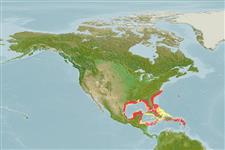Common names from other countries
Environment: milieu / climate zone / depth range / distribution range
Ecologie
marien rifbewoner; diepte 0 - 100 m (Ref. 108738), usually 0 - 18 m (Ref. 7251). Subtropical; 37°N - 15°N
Western Atlantic: southern Chesapeake Bay south along the U.S., Bahamas, throughout the Gulf of Mexico except northwestern Cuba; in the Caribbean from southern Jamaica, and along Central and South America from Mexico to the Honduran Bay Islands, and Colombia to Brazil (Santa Catarina).
Grootte / Gewicht / Leeftijd
Maturity: Lm ? range ? - ? cm
Max length : 20.0 cm TL mannelijk / geslacht onbekend; (Ref. 7251)
Inhabits hard sand bottom from water's edge to 18 m depth, occasionally to 90 m.
Levenscyclus en paargedrag
Maturities | Voortplanting | Spawnings | Egg(s) | Fecundities | Larven
Distinct pairing (Ref. 205). Oviparous (Ref. 101737). Females produce numerous eggs in multiple spawnings during a prolonged spawning period (Ref. 101737).
Robins, C.R. and G.C. Ray, 1986. A field guide to Atlantic coast fishes of North America. Houghton Mifflin Company, Boston, U.S.A. 354 p. (Ref. 7251)
Status op de Rode Lijst van het IUCN (Ref. 130435)
CITES (Ref. 128078)
Not Evaluated
Gevaar voor de mens
Harmless
Gebruik door de mens
Tools
Can't connect to MySQL database fbquizv2. Errorcode: Too many connections
